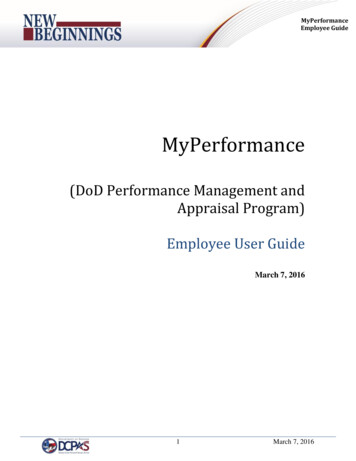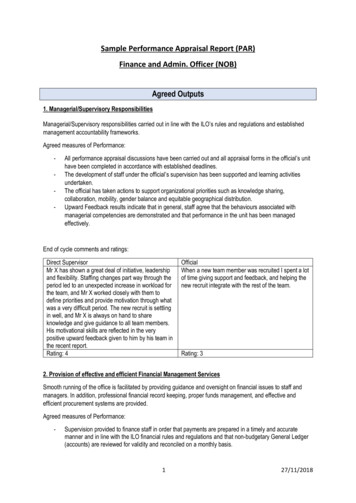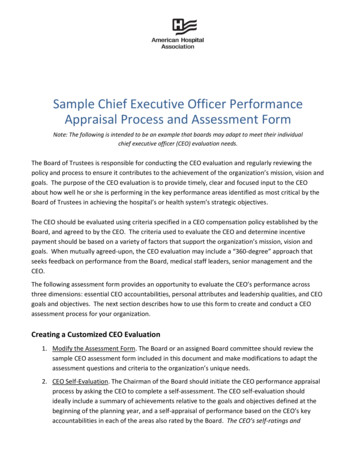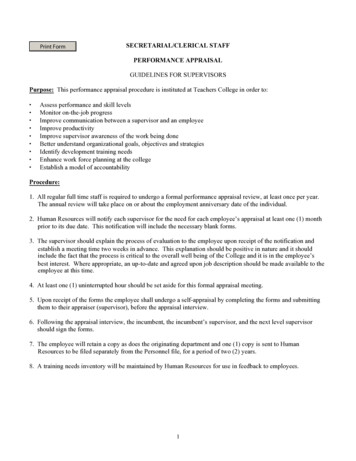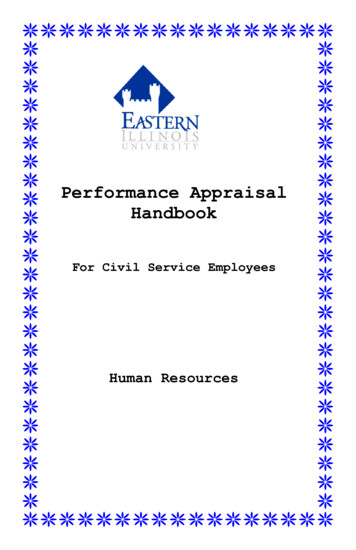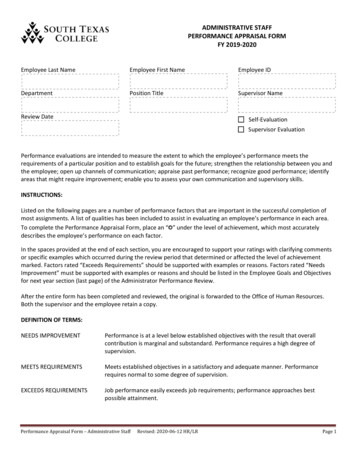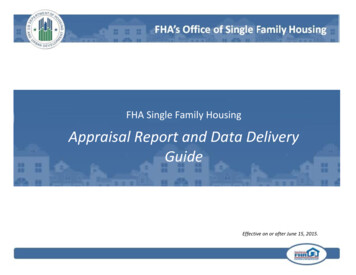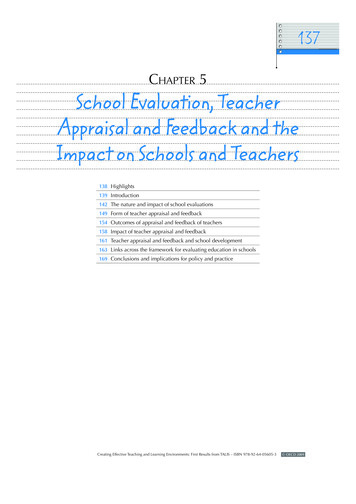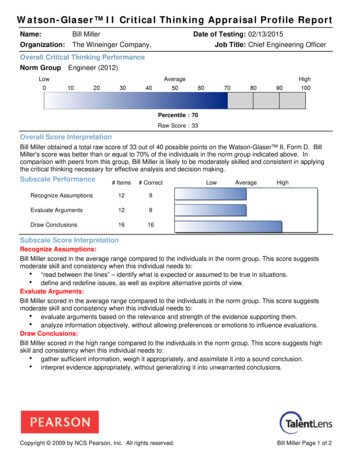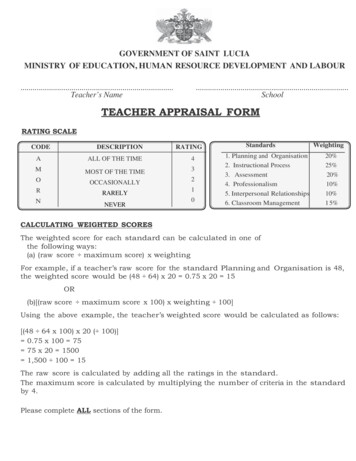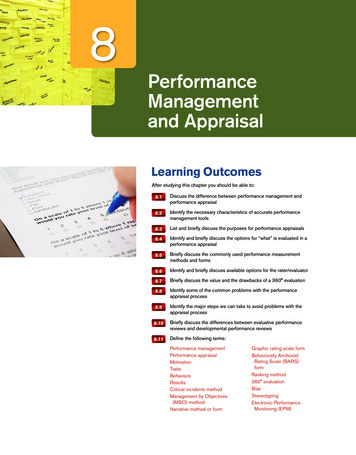
Transcription
8PerformanceManagementand AppraisalLearning OutcomesAfter studying this chapter you should be able to:8.1Discuss the difference between performance management andperformance appraisal8.2Identify the necessary characteristics of accurate performancemanagement tools8.3List and briefly discuss the purposes for performance appraisals8.4Identify and briefly discuss the options for “what” is evaluated in aperformance appraisal8.5Briefly discuss the commonly used performance measurementmethods and forms8.6Identify and briefly discuss available options for the rater/evaluator8.7Briefly discuss the value and the drawbacks of a 360 evaluation8.8Identify some of the common problems with the performanceappraisal process8.9Identify the major steps we can take to avoid problems with theappraisal process8.10Briefly discuss the differences between evaluative performancereviews and developmental performance reviews8.11Define the following terms:Performance managementPerformance appraisalMotivationTraitsBehaviorsResultsCritical incidents methodManagement by Objectives(MBO) methodNarrative method or formGraphic rating scale formBehaviorally AnchoredRating Scale (BARS)formRanking method360 evaluationBiasStereotypingElectronic PerformanceMonitoring (EPM)
Chapter 8 OutlinePerformance Management SystemsPerformance Management Versus Performance AppraisalThe Performance Appraisal ProcessAccurate Performance MeasuresWhy Do We Conduct Performance Appraisals?CommunicatingDecision Making (Evaluating)Motivating (Developing)Evaluating and Motivating (Development)What Do We Assess?Trait AppraisalsBehavioral AppraisalsResults/Outcomes AppraisalsWhich Option Is Best?How Do We Use Appraisal Methods and Forms?Critical Incidents MethodManagement by Objectives (MBO) MethodNarrative Method or FormGraphic Rating Scale FormBehaviorally Anchored Rating Scale (BARS) FormRanking MethodWhich Option Is Best?Who Should Assess rs360º EvaluationWho Do We Choose?Performance Appraisal Problems to AvoidCommon Problems With the Performance AppraisalProcessAvoiding Performance Appraisal Process ProblemsDebriefing the AppraisalThe Evaluative Performance Appraisal InterviewThe Developmental PerformanceAppraisal InterviewTrends and Issues in HRMIs It Time to Do Away WithPerformance Appraisals?Technology: Electronic Performance MonitoringCompetency-Based Performance ManagementAligning the Appraisal ProcessC.Job Analysis/Job Design (required)4. Performance management (performance criteria and appraisal)F.Performance Management (required)1. Identifying and measuring employee performance2. Sources of information (e.g., managers, peers, clients)3. Rater errors in performance measurement4. Electronic monitoring5. Performance appraisals6. Appraisal feedback7. Managing performanceCase 8-1. Beauty and the Beastly Situation at Aerospace Designs’ MarketingDepartmentCase 8-2. Performance Evaluation at DHR: Building a Foundation orCrumbling Ruins?SHRMHR CONTENTSee Appendix A:SHRM 2010 CurriculumGuidebook for thecomplete list
284 PART III: DEVELOPING AND MANAGINGPerformance Management MiscueMost managers don’t look forward to performanceappraisals. As soon as Heather stuck her head in my officeand asked me to sit in on her performance appraisal, Iknew I had two employees who needed some coaching—Heather and her supervisor, Christine. Our company basesmany employment decisions on performance appraisals,so the results are important.Wh e n I e n t e r e d t h e r o o m , i t b e c a m e a p p a r e n tthat although Heather believed she had been doing agreat job, Christine did not agree. Christine recordedHeather’s performance as needing improvement overall, but did not offer any reason beyond a vague chargethat Heather had a poor attitude and wasn’t a teamplayer.I quickly suggested a small interruption to the meeting, andasked Heather to step out of the room. It soon becameclear that the overall problem was Heather’s failure toreport to work on time. When Heather was late, it impactedher entire work group as the other employees then had toanswer Heather’s phone calls.What’s going on here? Why don’t Heather and Christineagree on Heather’s performance? Where did Christinego wrong? How can Christine get Heather to agree withher performance review now? How can this problem beavoided during the next formal performance appraisal session? The answers to these questions are based on havinga good performance management system. By reading thischapter, you will learn how you can avoid these problems.The Practitioner’s Model for HRM Productivity Satisfaction Absenteeism TurnoverSection IV: Compensating and ProtectingHow do you REWARD and MAINTAIN your Human Resources?Section III: Developing and ManagingHow do you MANAGE your Human Resources?Section II: Attracting and StaffingWhat HRM Functions do you NEED for sustainability?Section I: 21st-Century HRM Strategic Planning and Legal IssuesWhat HRM issues are CRITICAL to your organization’s long-term sustainability?
Chapter 8: Performance Management and Appraisal 285Performance Management SystemsAt this stage of human resource management (HRM), we now have employees in ourorganization who can do the work, we’ve given them at least some initial training, and theyare now doing their individual jobs. What’s next? The next issue that we need to figure outis how to manage their performance over time to ensure that they remain productive, andhopefully become even more capable, as they progress in their careers. Remember our discussion from Chapter 1 that our human resources are typically one of the few options available to create a sustainable competitive advantage for the firm. So we need to ensure thatour human resources perform at the highest possible level. To this end, in this section, wediscuss the difference between performance management and performance appraisal, andpresent the performance appraisal process.LO 8.1Discuss the differencebetween performancemanagement andperformance appraisal.Performance ManagementVersus Performance Appraisal“In a knowledge economy, organizations rely heavily on their intangible assets to buildvalue. Consequently, performance management at the individual employee level is essential and the business case for implementing a system to measure and improve employeeperformance is strong.”1 Management time and effort to increase performance not onlymeets this goal; it also decreases turnover rates.2How do we manage performance within the organization? The most common part ofthe process, and the one with which we are most familiar, is the process of the performanceappraisal, or evaluation. In this chapter, we will use the phrases performance evaluation, performance appraisal, and appraisal interchangeably. However, the performance appraisalprocess is not the only thing that’s done in performance management. Performancemanagement is the process of identifying, measuring, managing, and developing the performance of the human resources in an organization. Basically we are trying to figure out howwell employees perform and then to ultimately improve that performance level. When usedcorrectly, performance management is a systematic analysis and measurement of workerperformance (including communication of that assessment to the individual) that we use toimprove performance over time.Performance appraisal, on the other hand, is the ongoing process of evaluating employeeperformance. Performance appraisals are reviews of employee performance over time3, soappraisal is just one piece of performance management. Although we will spend most ofthis chapter discussing performance appraisal, there are several other significant pieces ofperformance management that we already covered in past chapters and will cover in futurechapters. We discussed “strategic planning,” which provides inputs into what we wantto evaluate in our performance management system, in Chapter 2. We also discussed themajor method of identifying performance requirements in a particular job when we wentthrough “job analysis and design” in Chapter 4. In Chapter 7, we discussed “training anddevelopment,” which obviously play a part in performance management. Additionally, wewill discuss motivating employees, employee relations, compensation, and other pieces inChapters 9–14. Now that we understand the difference between performance managementand performance appraisal, let’s look at the performance appraisal process.The Performance Appraisal ProcessExhibit 8-1 illustrates the performance appraisal (PA) process. Note the connectionbetween the organization’s mission and objectives and the performance appraisal process.Here we briefly discuss each step of the process.SHRMGuide – C:4 Performance management(performance criteria andappraisal)Video Link 8.1Performance AppraisalProcess
286PART III: DEVELOPING AND MANAGINGExhibit 8-1The Performance Appraisal ProcessStep 1:Job AnalysisOrganizational Missionand ObjectivesStep 2: Develop standardsand measurement methods;communicate standards toworkforceStep 4: Prepare for andconduct the formal PAStep 3: Informal PA —coaching and disciplineStep 1. Job analysis. This is logically our first step because if we don’t know what ajob consists of, how can we possibly evaluate an employee’s performance? We alreadylearned how to do a job analysis in Chapter 4, but as shown in Exhibit 8-1, we shouldrealize that the job must be based on the organizational mission and objectives, thedepartment, and the job itself.Step 2. Develop standards and measurement methods. If we don’t have standardsof acceptable behavior and methods to measure performance, how can we assess performance? We will discuss performance measurement methods in the next part of this section, and in the major section “How Do We Use Appraisal Methods and Forms?” we willdiscuss these topics in more detail.Step 3. Informal performance appraisal—coaching and disciplining. PerformanceWORKAPPLICATION 8-1Select a job you have orhad. Did you know theorganization’s mission andobjectives? Briefly state themission. If you don’t know it,find out. Did you understandhow your job fits or helpsto meet the mission andobjectives? Explain insome detail.appraisal should not be simply a once- or twice-yearly formal interview. As its definitionstates, performance appraisal is an ongoing process. While a formal evaluation may onlytake place once or twice a year, people need regular feedback on their performance to knowhow they are doing.4 We will briefly discuss coaching in the “Critical Incidents Method”subsection of “How Do We Use Appraisal Methods and Forms?” and in more detail alongwith teaching how to discipline in the next chapter.Step 4. Prepare for and conduct the formal performance appraisal. The commonpractice is to have a formal performance review with the boss once or sometimes twice a yearusing one or more of the measurement forms we will be learning about. Later in this chapter wewill discuss the steps of preparing for and conducting the performance appraisal.In the major sections to come, we discuss “why” we assess performance, “what” weassess, “how” we assess, and “who” conducts the performance appraisal. Then we discussperformance appraisal problems and how to avoid them, and we end the performanceappraisal process with the actual formal review session. But before we leave this section, weneed to understand a critically important part of each step in the performance appraisalprocess—accurate performance measurement.
Chapter 8: Performance Management and Appraisal 287Accurate Performance MeasuresPerformance should be accurately measured so employees will know where they canimprove.5 Knowing where to improve should lead to training employees to develop newskills to improve.6 To be an accurate measure of performance, our measure must be validand reliable, acceptable and feasible, specific, and based on the mission and objectives. Let’sdiscuss each here.LO 8.2Identify the necessarycharacteristics of accurateperformance managementtools.Valid and reliable. As with all areas of our people management process, we mustmake sure that all of our performance management tools are valid and reliable. Hereagain, we can pull out and dust off the OUCH test as a quick measure to ensure fairnessand equity in the performance management and appraisal process. We rememberby now that OUCH stands for Objective, Uniform in application, Consistent in effect,and Has job relatedness, right? However, we still need to analyze validity and reliabilityin some detail.If our method of measurement is not valid and reliable, then it makes no sense to use it.We discussed reliability and validity in Chapter 4. Recall that a valid measure is “true andcorrect.” When a measure has validity, it is a factual measure that measures the process thatyou wanted to measure. A reliable measure is consistent; it works in generally the same wayeach time we use it.Acceptable and feasible. In addition to validity and reliability, we need to look at a coupleof other characteristics of our performance measures. We need to analyze acceptability andfeasibility. Acceptability means that the use of the measure is satisfactory or appropriate to thepeople who must use it. However, in performance appraisal, this isn’t enough.7 Acceptabilitymust include whether or not the evaluation tool is feasible. Is it possible to reasonably applythe evaluation tool in a particular case? As an example, if the performance evaluation formis two or three pages long and covers the major aspects of the job that is being evaluated, andboth managers and employees believe that the form truly evaluates performance measuresthat identify success in the job, then they are likely to feel that the tool is acceptable and feasible. If, however, the manager must fill out a 25-page form that has very little to do with thejob being evaluated, the manager may notfeel that the form is acceptable or feasible,at least partially due to its length, even if theemployee does.Conversely, if managers fill out a twopage evaluation that they feel is a true measure of performance in employees’ jobs butthe employees feel that the evaluation leavesout large segments of what they do in theirwork routine, they may not feel that the formis acceptable and feasible. If either management or employees feel that the form isunacceptable, it most likely will not be usedcorrectly. So, we always have to evaluateacceptability and feasibility of a measure.Specific. Next, we want any evaluationmeasure to be specific enough to identify what is going well and what is not.The word specific means that somethingis explicitly identified, or defined wellWithout accurate measures of performance, the performance appraisalcan’t be reliable or valid.
288PART III: DEVELOPING AND MANAGINGWORKAPPLICATION 8-2Assess the accuracy of themeasurements of yourperformance on your lastperformance appraisal. Besure to describe the measures’validity and reliability, theiracceptability and feasibility,if they were specific, andif they were based on theorganization’s mission andobjectives.8-1enough that all involved understand the issue completely. In performance appraisal, specific means that the form provides enough information for everyone to understand whatlevel of performance has been achieved by a particular employee within a well-identifiedjob.Creating specific measures is the only way that we can use a performance appraisal toimprove the performance of our employees over time. The employees have to understandwhat they are doing successfully and what they are not. Many times, evaluation forms maybe too general in nature to be of value for modifying employee behaviors because we wantthe form to serve for a large number of different types of jobs. This can create significantproblems in the performance appraisal process.Based on the mission and objectives. Finally, you want to make sure thatyour performance management system leads to accomplishment of your organizational mission and objectives. As with everything else we do in HR, we need to ensurethat the performance management process guides our employees toward achievement of the company’s mission and objectives over time. As managers in the organization, making sure of this connection will allow us to reinforce employee behaviors thataim at achieving organizational goals and to identify for our employees things that they maybe doing that actively or unintentionally harm our ability to reach those goals.Thus, stating specific objectives of exactly what each person in each job should achieveor his or her performance outcomes leads to accurate assessment that can increase performance. For some examples of inaccurate measures of performance, complete Applying theConcept 8-1.APPLYING THE CONCEPTMeasurement AccuracyWhich of the following criteria for a measure to be accurate is not met in each of the given situations?a. validb. reliablec. acceptedd. feasiblee. specificf. based on the mission and objectives1. My boss asked me to fill out a self-evaluation of my performance. But I refused to do it. Evaluation isher job, so let her do it.2. My boss told me that I was not doing a very good job of data entry. When I asked him what he meant, hewent around in circles and never gave me a good answer.3. The boss said I’m not producing as many widgets as I used to. But it’s not my fault that the machinejams every now and then and I have to stop working to fix it.4. My boss asked to me to evaluate my employees four times a year instead of only once. I told her I don’thave the time to do it that many times. It’s just not possible to do a good review that often without cutting backother things that are more important.5. My boss said I have a bad attitude and gave me a lower overall rating. But I pointed out that I get all mywork done well and by the deadline or early, and I questioned what my attitude had to do with my performance.
Chapter 8: Performance Management and Appraisal 289Why Do We ConductPerformance Appraisals?As you can begin to see already, the appraisal process gets extremely complicated very quickly.And remember, anytime a process in an organization is complicated, it costs a lot of money.So why do we even do performance appraisals? What value provided to the organization andto the individual makes the process of evaluating the performance of our workers so critical?If performance appraisals are done in the correct manner, they can provide us with aseries of valuable results. However, done incorrectly, the process of evaluating employeeperformance can actually lead to lower levels of job satisfaction and pro ductivity. Inthis section, let’s discuss three major reasons why organizations complete performanceevaluations—communicating, decision making, and motivating.CommunicatingThe first major reason for performance appraisal is to provide an opportunity for formalcommunication between management and the employees concerning how the organizationbelieves each employee is performing. All of us know intuitively that successful communication requires two-way interaction between people. “Organizations can prevent or remedy the majority of performance problems by ensuring that two-way conversation occursbetween the manager and the employee, resulting in a complete understanding of what isrequired, when it is required and how the employee’s contribution measures up.” 8Communication always requires that employees have the opportunity and ability toprovide feedback to their bosses in order to make sure that the communication is understood. So, in performance appraisals the communication process requires that we as managers communicate with the employees to provide them information about how we believethey’re doing in their job, but the process also requires that we provide the opportunity forthe employees to speak to us concerning factors that inhibit their ability to successfully perform for the organization.Factors in a job that management may not know about can include many things,including lack of training, poorly maintained equipment, lack of tools necessary to perform, conflict within work groups, and many other things that management may not seeon a daily basis. If the communication component of the performance appraisal processdoes not allow for this two-way communication, managers may not know of the obstacles that the employees have to overcome. The only way that we can resolve problems is toknow about them. So, as managers, we need to communicate with our employees to findout when issues within the work environment cause loss of productivity so we can fix them.Thus, two-way communication is a critical component of correcting problems through theperformance appraisal process.Decision Making (Evaluating)The second major purpose of performance appraisals is to allow management to makedecisions about employees within the organization. We need to make decisions based oninformation, the information we get from our communication. Accurate information isnecessary for management decision making and is an absolutely critical component to allowthe manager to improve organizational productivity.9 We use information from annual performance appraisals to make evaluative decisions concerning our workforce including payraises, promotions, demotions, training and development, and termination. When we havevalid and reliable information concerning each individual within our division or department, this gives us the ability to make decisions that can enhance productivity for the firm.LO 8.3List and briefly discuss thepurposes for performanceappraisals.
290PART III: DEVELOPING AND MANAGINGIf, for instance, through the process of coaching (the third step of the performanceappraisal process) we find that several machine operators are having trouble keeping theirequipment in working order, this piece of information would quite likely lead to a needsassessment (as discussed in Chapter 7) to determine whether or not maintenance trainingis necessary for our group of operators. Without our rigorous evaluation process, we mightnot learn of this common problem as early, and as a result could do some significant damage to very expensive equipment. This and similar types of information frequently come tothe forefront as we go through the performance appraisal process. Decision making basedon good communication is a very large part of why we take the time to do annual performance appraisals.SHRMGuide – F:7Managing PerformanceMotivating (Developing)The third major purpose for performance appraisal is to provide motivation to ouremployees to improve the way they work individually for developmental purposes, whichin turn will improve organizational productivity overall.10 What is motivation, and are performance appraisals normally motivational? Well, from a business perspective, motivationcan be defined as the willingness to achieve organizational objectives. We want to create thiswillingness to achieve the organization’s objectives, which in turn will increase organizational productivity.Our evaluative decisions should lead to development of employees. Returning tothe machine operators having trouble keeping their equipment in working order, making the decision to train the employees leads to their development through improvingtheir performance, as well as better utilizing the resources to improve organizationalperformance.Evaluating and Motivating (Development)An effective performance appraisal process has two parts (evaluating and motivating), andit does both parts well. Evaluating is about assessing past performance, and motivating isabout developing employees to improve their future performance. But, are both parts donewell? Have you ever been in a position of being evaluated and debriefed as an employee?Was the process motivational? Probably not. Think about the appraisal process and howit was carried out. Here we discuss problems with evaluation and how to overcome them,explain how to motivate, and suggest separating evaluation and motivation.Problems with evaluation. A common problem in appraisals is overpowering employ-ees during an evaluation debrief with large amounts of negative information that they havenot heard during coaching. This tends to cause the employees to “turn off,” or stop listening to their managers as they explain what is wrong. Employees will just “raise their shields”to ward off all of the negative information. This is a natural human characteristic. We arenaturally suspicious of negative information for a variety of psychological reasons (defensemechanisms), so when employees are presented with a large amount of negative information, they tend to discount or even disbelieve it. They may consider the process unfair orone-sided and not an accurate measure of their performance, and as a result the evaluationmay be useless as a motivator.Avoiding problems with evaluation. To help overcome such problems with evaluation,an effective manager who is a good coach will generally never identify a weakness that theemployee has not previously been made aware of during the formal appraisal interview—there are no surprises. The evaluative part of the appraisal should only be a review of whatthe employee already knows and should be willing to hear. However, avoiding surprises isnot enough.11
Chapter 8: Performance Management and Appraisal 291The appraisal debrief must be a well-rounded look at individual employees; it shouldidentify both positive and negative factors in the employees’ behaviors and results withintheir job (and remember that the communication needs to be two-way). As managers,we want to tell employees what they are doing right, but also where they have room forimprovement. This more balanced approach to the debriefing process will minimize thepotential that the employees will raise those shields and avoid listening.Motivating development. The important part of development is the need for managersto provide motivational opportunities for employees to improve their performance overtime. In other words, we need to tell them how to fix the problem. We need to provide themwith tools, training, or other methods that will allow them to improve to the point wheretheir behavior is sufficient, and we then must continually strive to get them to perform atan above-average level and ultimately to be superior through ongoing coaching betweenformal reviews.If we provide employees with tools to allow them to improve over time, we’re focusing not on the negative past results but on the positive future potential results.12 If they aregiven an honest opportunity to fix something that they know is a problem and are given thenecessary tools or training, most will take advantage of that opportunity. So performanceappraisals can be motivational if they are properly used and debriefed.Separating evaluation and development. To improve both parts of the perfor-WORKAPPLICATION 8-3Assess the effectiveness ofan evaluative performanceappraisal you had. Did themanager present both positiveand negative performanceareas? Did you “really” listen?Were there any surprises?Explain any problems andhow the evaluation could beimproved.mance appraisal, we suggest splitting the debriefing into two separate interviews. The firstmeeting is to evaluate the employees’ past performance, pointing out strengths and areasfor improvement; the employees are asked to think about how they can improve their performance. At the second meeting, manager and employee jointly come up with a developmental plan that should lead to increased performance that will result in a higher futureevaluative rating during the next formal appraisal. We will discuss how to conduct the twoseparate interviews in the “Debriefing the Appraisal” major section of this chapter.What Do We Assess?Now that we know why we conduct performance appraisals, the next step is to figure out whatneeds to be evaluated. In other words, we have to decide what aspects of the individuals andtheir performance we’re going to measure. The best option for what we evaluate would comefrom analyzing the essential functions and qualifications required for a particular job—or, inHR terms, our job analysis. We could then use these facts to design an appraisal instrumentwith measurable and observable factors with which performance can be evaluated.13 However, we can’t evaluate everything that is done over the course of the year. We have to choosewhat we will focus on because if we can’t measure it, we can’t manage it, and what gets measured and evaluated gets done.14 Our three primary options are traits, behaviors, and results.Trait AppraisalsTraits identify the physical or psychological characteristics of a person. We can evaluate thetraits of an individual during the performance appraisal process. Can we accurately measure traits that affect job performance, can trait measures pass the OUCH test, are traitscommonly used to measure performance, and should we measure traits as part of our performance appraisal process? Here we answer these questions, and we will answer these samequestions for our behavior and results options.Can we accurately measure traits that affect job performance? Certainly, there’ssome evidence that particular types of traits are valuable in jobs that require managementand leadership skills. Characteristics such as inquisitiveness, conscientiousness, and generalLO 8.4Identify and briefly discussthe options for “what” isevaluated in a performanceappraisal.
292PART III: DEVELOPING AND MANAGINGcognitive ability have been shown to have a reasonable “link” to job performance.15 But justhow accurate is the link?Many traits that most of us would be likely to focus on, such as physical attractiveness,height, extroversion, and others, actually have been shown to have very little bearing on jobperformance. If we’re going to use traits in performance evaluation, we must ensure thatwe focu
correctly, performance management is a systematic analysis and measurement of worker performance (including communication of that assessment to the individual) that we use to improve performance over time. Performance appraisal, on the other hand, is the ongoing pro
